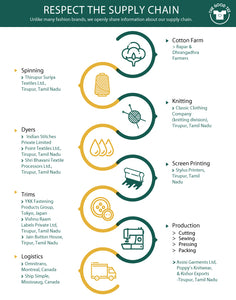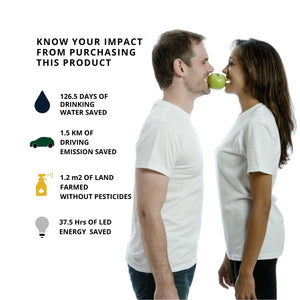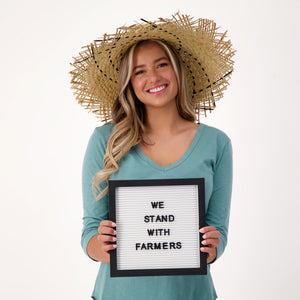The Ultimate Guide To The Printing Process On Organic Cotton T-Shirts

Welcome to the exciting world of screen printing! As a business owner, you have a powerful tool at your disposal to create customized and eye-catching designs on clothing and fabric items. Screen printing allows you to showcase your brand, convey your message, and stand out from the competition. In this beginner's guide, we will take you through the step-by-step process of working with a screen printer, equipping you with the knowledge to unleash your creativity and make a lasting impression.
Choice of Fabric

When it comes to fabric choices for screen printing, there are several options available, each with its own benefits. Fabrics like ring-spun cotton and jersey cotton are commonly used due to their unique characteristics. However, among these fabric options, organic cotton stands out as a more beneficial choice for both the environment and consumers. Organic cotton, a natural fibre, is not only smoother but it is more durable. As a natural fibre, is is better for out planet as is naturally biodegrades. It is grown without synthetic pesticides, promoting environmental sustainability and supporting healthier working conditions. Organic cotton offers superior print quality, vibrant colors, and a softer feel. By choosing organic cotton, you contribute to a sustainable and ethical supply chain, making a positive impact on the environment and communities.
How long does the process take?
The duration of the screen printing process depends on factors such as the complexity of the design, the quantity of items, the fabric type, the ink used, and the printer's workload. While the setup and cleanup phases tend to be the most time-consuming, the actual screen printing itself typically takes no more than five minutes per shirt, especially when utilizing a machine. However, it's important to consider additional time for t-shirt preparation and scheduling to meet delivery deadlines. To ensure timely delivery, it is recommended to work with screen printers two to three weeks in advance. This allows sufficient time for all steps involved in the process, resulting in a smoother and more efficient experience.
Here’s a quick glimpse into what is involved in screen printing customized t-shirts.
1: Design Creation and Preparation

To begin, it's essential to have a finalized design that captures the essence of your brand. Consider your business identity, target audience, and the message you want to convey. Whether it's a logo, slogan, or graphic, let your creativity flow as you envision the design you want to bring to life. When preparing artwork for your screen printer, provide vector artwork in PDF or AI format. Vector files ensure optimal quality and compatibility with the printing process. Each color in your design will require a separate screen, which may incur additional charges. To minimize costs, consider reducing the number of colors used while maintaining the impact of your design. The base color of your t-shirt can also affect costs.
Generally, a white t-shirt will cost less compared to a coloured t-shirt.
2: Screen Preparation
The success of screen printing lies in the preparation of the screen itself. Screen printers select the appropriate screen mesh count, with higher mesh counts for intricate designs and lower counts for bold and straightforward designs. They apply emulsion to the screen, creating a light-sensitive layer that will form the stencil for your design. Keep in mind that each color in your design requires a separate screen. When you're working with a screenprinter, remember that every screen is an additional charge so it's best to use fewer colors in your artwork.
3: Creating the Stencil

With your design and screen ready, it's time to create the stencil. Screen printers place a transparent acetate sheet with your design on top of the coated screen and expose it to bright light. The light causes the emulsion to harden, leaving behind stencil openings that correspond to your design. The screen is then rinsed with water to remove the unexposed emulsion, revealing a clear and defined stencil.
4: Printing Preparation
Now that the stencil is created, the screen printers proceed to set up the printing process using water-based inks. They secure the screen onto the printing press, ensuring it is tightly secured and properly aligned. These environmentally friendly inks, which utilize water as the main solvent, are chosen for their sustainability benefits. As the screen printers prepare your chosen fabric items, such as shirts or promotional products, they lay them flat on the printing board. It is important to ensure that the substrate is clean, free from any wrinkles or obstructions that could affect the printing quality.
In line with the commitment to sustainability, customisation with The Good Tee uses water-based ink colors that not only suit your fabric but also offer compatibility with screen printing techniques. These inks have lower toxicity, making them safer for workers and consumers. They are easily recyclable and biodegradable, minimizing harm during waste disposal. Water-based inks find applications in packaging, textile printing, graphic arts, and labels. They offer vibrant colors, good adhesion, and comparable print quality to solvent-based inks while maintaining environmental sustainability. Look for certifications and eco-labels to ensure their sustainable credentials.
5: Printing Process
This is when the magic happens. The screen printers apply ink to the top of the screen, directly above the stencil openings. Using a squeegee, they apply downward pressure and smoothly pull it across the screen, distributing the ink evenly and pushing it through the stencil openings onto the fabric. If your design has multiple colors, they repeat this process for each color, aligning the screens carefully to ensure proper registration.
6: Drying and Curing
Patience is key in the final step. The screen printers allow your printed items to dry completely, ensuring the ink sets properly and achieves a lasting finish. Depending on the type of ink used, the items may need air drying, which can take several hours overnight, or heat curing, which typically takes a few minutes per item using a heat press or conveyor dryer.
Congratulations on discovering the incredible potential of screen printing for your business! By harnessing this powerful technique, you can create custom designs on clothing and fabric items that truly embody your brand's identity. Screen printing offers an affordable and versatile way to elevate your marketing efforts, promote your business, and produce unique merchandise that captivates your audience.

At The Good Tee, we are excited to be your partner in this journey. Open a wholesale account today and unlock the boundless possibilities of personalized tees that stand out from the crowd. Our commitment to premium quality is reflected in our fabric, crafted from 100% organic cotton. Experience the perfect fit, vibrant designs, and exceptional durability that our fabric offers. Don't miss out on this opportunity to elevate your brand's visibility and create something extraordinary. Get started today by filling out our quote form here. Our dedicated team is here to support you every step of the way. Have questions or need assistance? Contact us at hello@thegoodtee.com. Together, let's make your mark with custom tees that inspire and captivate.







Leave a comment